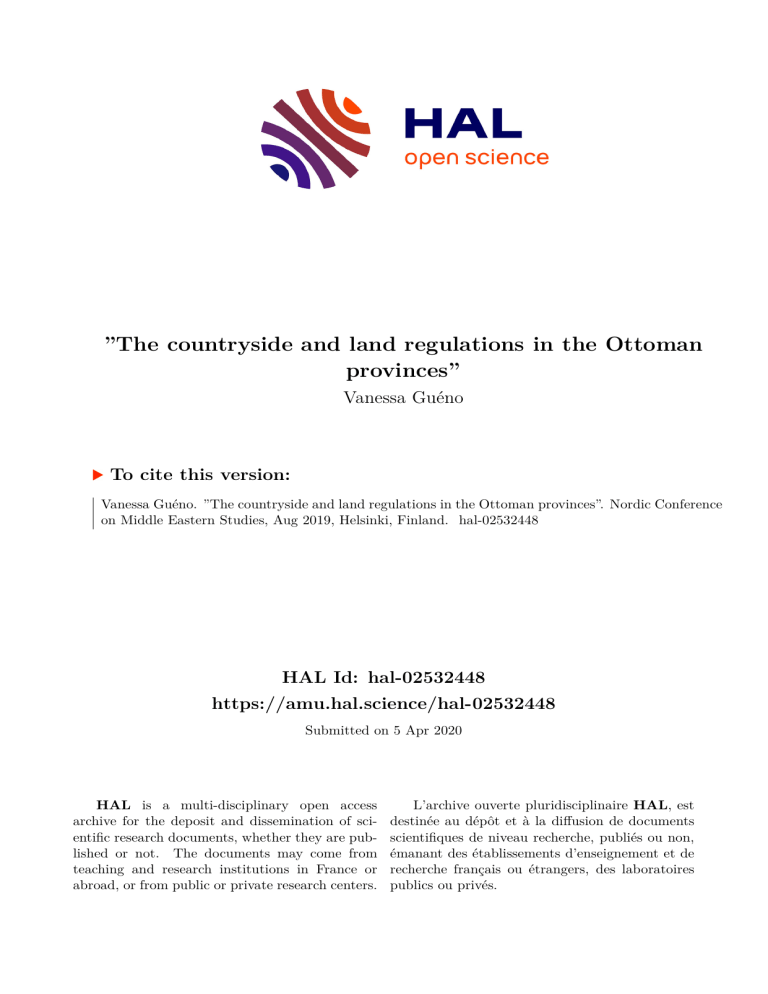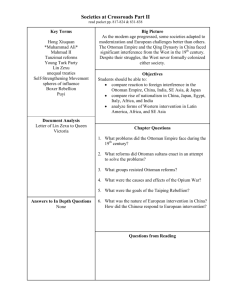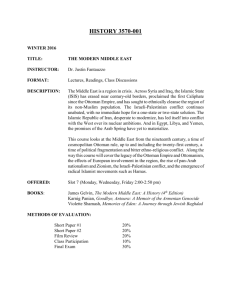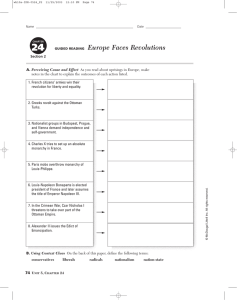
”The countryside and land regulations in the Ottoman provinces” Vanessa Guéno To cite this version: Vanessa Guéno. ”The countryside and land regulations in the Ottoman provinces”. Nordic Conference on Middle Eastern Studies, Aug 2019, Helsinki, Finland. �hal-02532448� HAL Id: hal-02532448 https://amu.hal.science/hal-02532448 Submitted on 5 Apr 2020 HAL is a multi-disciplinary open access archive for the deposit and dissemination of scientific research documents, whether they are published or not. The documents may come from teaching and research institutions in France or abroad, or from public or private research centers. L’archive ouverte pluridisciplinaire HAL, est destinée au dépôt et à la diffusion de documents scientifiques de niveau recherche, publiés ou non, émanant des établissements d’enseignement et de recherche français ou étrangers, des laboratoires publics ou privés. Nordic Conference on the Middle Eastern Studies, August 2019, Helsinki (Finland) The Boundaries of State Intervention: dealing with ‘property’ in modern Syria. Panel organisor: Matthieu Rey Panel Chair : Riina Isolato Wednesday 14.8. 14.30 – 16.00, Sessions III The present panel aims to historicize the relationship between the state and individuals through a reconsideration of the status of property. Law n°10, recently issued by Bashar al-Assad, aroused controversy as it allowed the regime to deprive certain citizens of their rights to own land. The terms of the debate quickly turned to sectarian issues and discussion of how the law enables the Syrian regime to override the Sunni majority and increase the access to property for the minorities. This panel departs from the sectarian hypothesis by highlighting how the very notion of property has been shaped by the emergence of the modern Syrian state (post Tanzimat era), and evolved alongside the dynamic of the state. Authorities have tried to encroach on local power through the definition of landowners’ rights. By focusing on three different stages, the Ottoman period, the Independence, and the current time (from the war to post-conflict stage), the panel aims to explain how property has always been at the core of the dialogue between individuals and authorities, as both struggled to preserve or extend their prerogatives on the local stage. Studying the role and status of property underlines how the state exercised its power overs its territory. The countryside and land regulations in the Ottoman provinces Vanessa Guéno, Aix-Marseille University & IREMAM The present communication aims to discuss the rural conflicts which arose from the mid-19thcentury Ottoman reform. While recent studies of the Syrian countryside have given an in-depth analysis of the economic aspects of these reforms, the new social relations and the evolution of the laws they engendered, research has focused on how the implementation – and first of all, the translation of the law – at the local stage affected the relations of domination between the notables (‘ayān), who maintained ownership of the land, and the farmers who worked on that land. Studying these relations allows us to understand the new relationship established between the Ottoman authorities and local elites. It also allows us to analyse the interpretation of the law, and explain how this legal category introduced by the reforms empowered some specific groups at the local stage, forcing the reorganisation of the political elites in Ottoman Syria. This presentation is based mostly on an in-depth reading of religious and secular tribunals (shāri‘ and nizāmī) in the Tabū archive. 1 In the 19th century, rural areas made up the greater part of the territory of the Ottoman Empire, and people living in rural areas made up around 70% per cent of the total population1. Revenues from land were greatest economic resource. As a result - during the Tanzimat period- the changes in land ownership that came after the major series of reforms carried out by Istanbul represent a turning point in the history of Ottoman rural both in the exploitation and division of land at local and provincial levels. This paper aims to draw an overview of the Ottoman land tenure reform and its consequences. I will focus on two points. Firstly, I question the concept of property and ownership in regard to the different status of land in the Ottoman Empire and especially in Province of Suriyya (Wilâyat Suriyya). In a second time, the paper focused on the application of the new laws in local ottoman court and more specifically in the city of Homs. In this way, we will show the actors of land and their understanding and practice of the new regulation. I. Land tenure in the Ottoman Empire In the Ottoman Empire and more specifically in Syria, the super-imposition of laws and customs led to confusion among the actors in the field, who used the same terminology for different practices. - Before the land tenure reform Older Ottoman law based on the distinction between the public domain (mîrî) and the private domain (mulk) was sur-imposed on traditional Islamic law dividing lands into two categories of ushr (tithe) land (private) and kharaj (tribute) land and Hanafi jurisprudence that defined three major legal categories of land: public land or imperial land (sultânî or mîrî), land making up a religious endowment (waqf) and land of private property (mulk). In 1673 a collection of laws giving the general outlines of the Ottoman land tenure system was promulgated in Istanbul in the form of the Kanun-I Cedid Osmani. This single text, according to Melissa Taylor studies, formed the basis of the Land Ottoman Code promulgated in 1858. According to the local religious courts, most of the arable land in Syria and Palestine was in the public domain (mîrî). The status of mulk (private property) seems to have been restricted to buildings and irrigated gardens (like kitchen gardens, vineyards, and orchards). People who worked the land were simply holding it as usufruct and only benefitted from a right of use (haqq al-tasarruf)2. - 1 2 Changes in the 19th century In Homs district, I estimated rural population around 60%. That right in Damascus was generally called by the expression “mashadd maska” in the local court records. 2 In the 19th century Mediterranean, legal rules were secularized, rationalized and modernized, and all aspects of the Ottoman institutions were transformed. As a result, land tenure system redefined the conditions of access to the land and actors had to adapt to changes. In 1858, the land code redefined the legal status of the land, but it only applied to land state domain (amiriyya). Land tenure system reform was announced in the Imperial Rescript of Gülhane (or law of Tanzimât) in 1839. In it, the sultan denounced the “harmful use of the venal concessions known as iltizâm.” According to Martha Mundy and Richard Saumarez Smith, “The rescript underscored the relation between the power of the state and the wealth of individuals as the basis of tax assessment; it called for an end to the personal administration of tax collection and for an expansion of official administrative departments”. Twenty years later, Istanbul promulgated the Land code. The system of tax farming (iltizâm) was abolished, and the status of private property (mulk) was reaffirmed as early as the first article of the Land Code: “Land is classified into five categories: 1. Land owned completely (mamlûka); 2. State land (amiriyya). 3. Land owned by religious endowments (mawqûfa); 4. Land given over the public use (matrûka), and 5. the fifth category is waste land (mawât). These five categories of land were regulated by new legislation brought together in various compilations of laws, including the Land Code, the Civil Code (Mecelle) and the regulations of Defter Khané (the Ministry of the cadaster). The laws governing possession for those working state land (arâdî amîriyya) were consolidated, and property (mulk) was redefined. Civil code (Mecelle), promulgated in 1869, is both the result of western influence (especially Code Napoléon)3 and a part of the Islamic law (first 100 articles) defined all the fundamental principles of Islamic Jurisprudence (fiqh)4. This code set out the legal mechanisms for various acts (sale, rent, security for a loan, guarantees…). In its, various articles repeated the concepts of ownership. Usufruct is not clearly defined, but the concept emerges through various articles limiting property rights. Nevertheless, some articles in it reveal the difficulties to uniform legislation in the Empire. For example, article 36 of the Mecelle, reiterates that Civil Code is considered the common source of laws but older usages are still considered valid if these are locally followed in the specific cases. In the nine following articles (37 to 45) customs are legitimated and customs are considered equal to the legal text. Finally, the application of laws took place through the necessary bureaucratic framework, leading to a multiplication of institutions and offices5. Created in 1871, Defter-i Hakani (Office of the Cadastre) and the ministry of the cadaster, set up locally in each province (wilâyat), district (liwâ’, qada’), recorded the land and delivered sanad tabu (possession title or usufruct title) and sanad mulkiyya or sanad tamlik (property title) to each new acquirer. Each item (houses, buildings, shops, part of land, well…) were registered to an owner in the property registers (daftar al-amlâk) or to a possessor in the lands register (daftar al-arâdî) by the employees 3 Mattei, 2000. Yildirim, 2005. 5 Bouquet, 2006. 4 3 (ma’mur al-tabu or katib al-tabu) of the cadaster in each village. The cadaster was also in charge of organizing public auctions of vacant mulk or amiriyya land. Henceforth, land’s property or possession is forbidden without regular or legal title. In the south of Ottoman Syria, the registration (yoklama) started in 1876. With this registration, Istanbul could collect tax efficiently. The public treasury should be set back. II. - Practice of the law and actors on the field! Limits of the experts According to local court registers, other experts were present at the local level. Expert witnesses from among the village headmen (mukhtâr), people having knowledge of the villages (alhal al-khibra), and surveyors (muhaddidîn or masahîn). The surveyorsmarked out the land in the field, registered all the land attached to each village, and acted as expert witnesses when demanded by the local courts. Government employees recorded all the land attached to each village in the records, giving the name and religious confession of each owner. However, neither the specific rights attached to each plot of land (right of use, right of passage) nor the land set aside for communal use (such as forested areas) were mentioned. Experts were representatives of the land reforms on the local level. But who were these individuals. Were they to be trusted? Article 88 of the Land Code forbade “any agent of the tapou (…) in his district and for the duration of his functions from acquiring vacant land or land coming under the procedures of the tabu. He may not cause it to be acquired by” his relatives either. This safeguard against abuses leads to a discussion of the way in which the central reforms were practiced on the local level. - Translating and understanding law New ottoman laws had to be published throughout the Empire before they could be applied. According to Heidborn in 1908, publication of laws started in 1873 in official journal in Constantinople and in the gazettes of the provinces. Heidborn adds that “whether published or not the laws were only intelligible to the tiny minority that was able to read official Turkish”. Despite a campaign to spread the use of Turkish throughout the legal institutions, “employees are completely uncertain” about the interpretation of the laws6. It is probably for these reasons that various translations of laws into Arabic were carried out by men who were well-versed in law, among them particularly Muḥammad Khālid al-Atāsī (1834–1908), the mufti of Homs. After resigning from his post, he translated the Mecelle and became a sort of expert to the civil court of the Homs subdivision. As a result, he was called upon in cases having to do with the status or the acquisition of 6 Heidborn, 1908 4 of land. Coming from a family of notables in the town, he was the only mufti summoned to testify before the Homs civil court. His former status as the town’s mufti led to his being trusted. He was considered to be an expert in the acquisition of property. He was also a landowner and had been involved in litigation with the cultivators of his land northwest of Homs. His dual competence probably enabled him to manage the cases in which he was involved in such a way as to retain and legitimate his own land holdings. The laws were translated on the local level, but there were definitely still different translations and interpretations of them owing to the problem of the linguistic differences that existed in the same region. Finally, those working the land, even if some of them were able to read Arabic, would definitely not have had the means to read the laws in Arabic and still less in Ottoman Turkish. Under such circumstances, only lawyers would have had access to the compilations of the laws, raising the question of how the reforms were applied and who the guarantors and beneficiaries of the new legislation were. The documentation produced by the local Ottoman courts sheds light on the administrative practices of the people from different backgrounds who used them. The voices of peasants, artisans, country dwellers, townspeople, tenants and landowners can all be heard, all arguing their cases in the hope of winning. III. Examples from court record (sijill) or empirical investigations - Local ottoman court Involving users coming from a wide range of social origins 7, the Ottoman courts of justice “gave voice” to users who set out their own claims in their own language. From 1879, the judicial reforms were applied through the establishment of the new civil courts (maḥākim niẓāmiyya) which were efficient in cases covering every area of law except personal status. Religious courts (maḥākim šar‘iyya) and civil courts8 operated jointly in each subdivision. The lawyers appointed to these two types of court were apparently the same people. But the cases the two types dealt with were very different, and different legal procedures were used in each court. The records of the religious courts dating from after the promulgation of the laws dealing with the management of property provide important information about types of land and the crops grown on them. Inventories of goods, orders regarding maintenance allowances, and documents regarding successions to the property of charitable trusts provide information about the property of various notables. For example, gardens and buildings were systematically considered to be the property (mulk) of their owner in conformity with the older laws. Gardens (bustān) were cultivated by gardeners who rented the land. 7 Peasants, garden workers, notables, landlords, tenants, holders of usufruct, artisans, merchants, bedouin, country dwellers, townspeople and government employees, … 8 Commercial, civil and penal sections 5 While the traditional court dealt with cases having to do with the transmission of land (inheritance, purchase, and sale), the first instance civil court dealt with complex litigation arising from land transfers that were not of the usual kind. - Legal vocabulary The concept of ownership had different meanings at different times and in different geographical areas. Some landowners could produce a deed of ownership (sanad tamlik), while others declared their right to the land with the support of an entry in the cadastral register (sanad ṭābū). Others presented themselves as the owners of the land (saḥib al-ārḍ) or to have been in obvious possession (bi-yadi-i) of plots for decades or generations. Each appropriated the idea of ownership in his own particular fashion. According to Halpérin, he right to property, “like every right, is a human artefact”. Hence, since law is a human construction, it can be used, abused, got round, or adapted according to human needs. Among other things, the courts of the Wilāyat Sūriyya produced documents of sale and purchase as well as of the transfer of land in the areas within their jurisdiction and were responsible for deciding conflicts over land ownership. For land that was owned outright (mulk), alienation could be carried out by sale (bi‘) or purchase (shirā’) of land identified in advance9. In cases where state land (amīriyya) was concerned, the process of alienation differed not so much in terms of the form employed as in the terminology that was used. For example, in March 1887, an act (qayd ḥujja) of procuration (wakāla) was drawn up in the name of a notable from Homs who was in charge of managing the property of ten villagers from the village of Maḥfūra10. The villagers were in possession of land spread out throughout the village, and with their consent the notable took care of selling it in plots. The act describes the property, made up of orchards (karm), houses (dār) and agricultural land (arḍ falaḥā). The orchards and houses were sold11. But the agricultural land was transferred12. Public land could not be sold because of its status, and only its usufruct was alienable against the payment called a badil. The price of the property was designated by the term ṯaman, this meaning “price,” whereas badil means “exchange.” State land was exchangeable. What would happen was that peasants did not systematically register their possession (yad) of land with the cadastre, fearing having to pay heavy taxes on it. They preferred to rent land that they had worked for generations. The notables acquired plots of public land either through public auction or by oral agreement (ṣulḥ) with those working it. 9 Once the agreed amount had been exchanged from the hand of the buyer to the hand of the seller (qabaḍa min yad al- mushtara li-yad al-bāī‘), the land was ceded to the acquirer (taslīm), and the buyer became its legal owner (qad ṣār kāmil haḏā al-mabī‘ mulkān shar‘iyyān). 10 Located north-west of Homs in the qaḍā’ of Ḥuṣn Al-Akrād. fī bi‘ mā huwa jār fi mulk 12 firāgh mā huwa jār taṣarruf 11 6 Whether it was a matter of registering or not registering land with the cadastral services, of purchase or transfer, or of simple agreements among local actors, such arrangements led to multiple cases of litigation. These could be resolved on a friendly basis, but around 30 per cent of the cases coming before the first instance civil court in Homs were nevertheless of rural origin. The long speeches that were made in the court sessions show not only the complexity of the relationships between the possessors and the cultivators of the land, but also the institutional and legal confusion that reigned after the introduction of the land reforms. The rural cases heard before the civil section of the court of first instance were always long. Strangely, the final judgments do not make any reference to the initial complaints. They simply confirm the legal right of one or more notables of the district to a piece of land and set out the limits (ḥudūd) of the land subject to the litigation, thereby legalizing an illegal monopoly. Conclusion Each province and each district exhibited significant differences from one another, not only as a result of older usages, but also because of the language and therefore of the terminology used. Such linguistic differences were felt not only in spatial terms in the form of dialectical nuances, but also in the various registers of the language that were used depending on the category of users concerned. The Ottoman context, and particularly that in the Arab provinces, was a generalized state of exception driven by the actors responsible for the changes in the land tenure system. Finally, the French mandate system that was later imposed inside new boundaries of Syria added a new layer of legal superimposition. Traditional, confessional, Ottoman, and now western legislation were all mixed up together. 7




